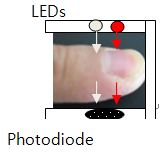
 Transmittance
Lights through the finger.
Transmittance
Lights through the finger.
 Transmittance
Lights through the finger.
Transmittance
Lights through the finger.
Light emitted by the LEDs is partially reflected, transmitted, absorbed,
and scatter by the skin and other tissues and blood it reaches the detector.
The probe of a pulse oximeter consists of two LEDs of selected wavelengths and a detector.
The wave length of the LEDs chosen are 660nm and 905 or 940nm (common Anode or Cathode).
This probe assembly must be protected from the ambient light for the wavelength to which the photodiode is sensitive.
Depending on the design, the cable may also contain a temperature sensor, to detect the temperature of the probe and underlying skin,
and the coding resistor to compensate for the variation of the wavelength of LEDs.
A pulse oximeter with transmittance probes uses the light transmitted through the extremity to arterial oxygen saturation of the blood.
The system employs two LEDs, with emission peak wavelengths at 660nm in the red range and 905 or 940nm in the infrared range.
APMKorea provides such reliable commercial sensors,
SMD packages for user’s easy application those are DDL2002 2002M 2003M 2005M 2007M, DDN2090 2090M 2091M 2092M 2093.
The LEDs are powered alternately so that light of one particular wavelength will pass through the tissue,
and transmitted light will be detected by the photodiode.
The intensity of the light emerging from the tissue is attenuated by the amount of blood present in the tissue.
This varies with the arterial pulse and is used as a measure to indicate the pulse rate.
The absorption coefficient of oxyhemoglobin is different from that of deoxygenated hemoglobin for most wavelengths of light.
For example, the infrared light is absorbed only by molecules made up of dissimilar atoms,
because only such molecules (e.g., CO2, CO, N2O, H2O and volatile anesthetic agents) possess an electric dipole moment
with which the electromagnetic wave can interact.
Symmetric molecules (e.g., O2, N2, H2) do not have an electric dipole moment and therefore do not absorb infrared radiation.
Thus differences in the amount of light absorbed by the blood at two different wavelength can be use to indicate arterial oxygen saturation.
In transmission probes, as the photodiode has to detect the light transmitted through the tissue,
the detector is placed is line with the LEDs so that the maximum amount of the transmitted light is detected.
The photodiode should be placed as close as possible to the skin without exertion force on the tissue.
The amount of force applied by reusable probes is much larger than the amount of force applied by disposable probes.
The force applied also depends on the materials used to manufacture a particular probe and also on the company which produces the probes.
If the force exerted by probe is significant, the blood under the tissue where the probe is placed, may clot due to external pressure applied.
And if you increase the distance between the LEDs and the photodiode (optical path length increases), the amount of detected light decreases by from Beer’ law.
Thus, you should place the LEDs and photodiode facing each other.
Normally transmission probes are placed on the patient’s finger, toe, ear or nose. In a clip type probe,
the distance between the LEDs and photodiode can be as much as 12mm.